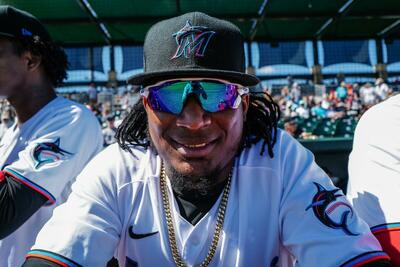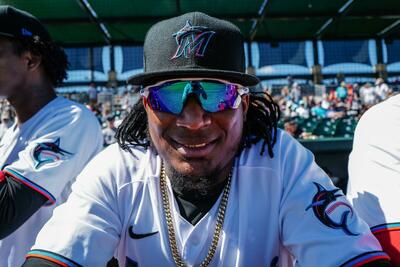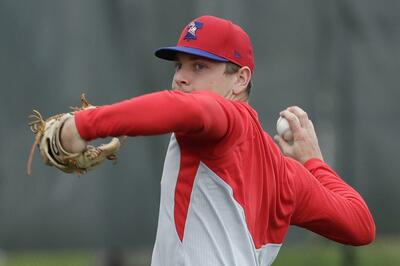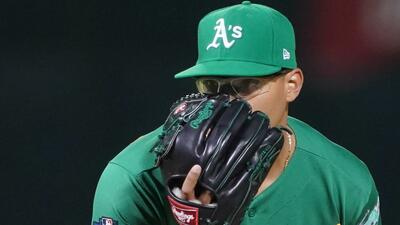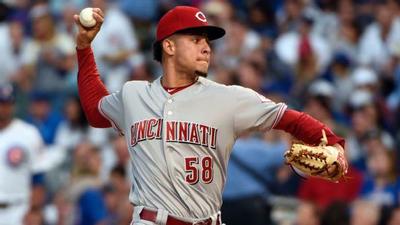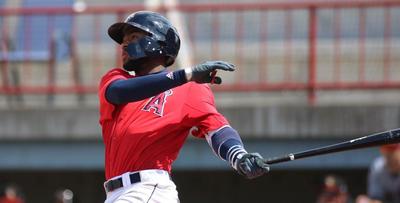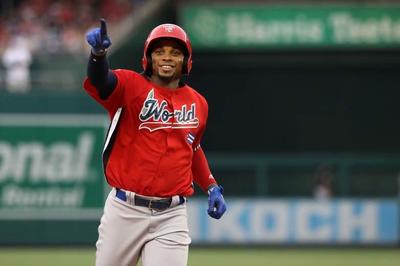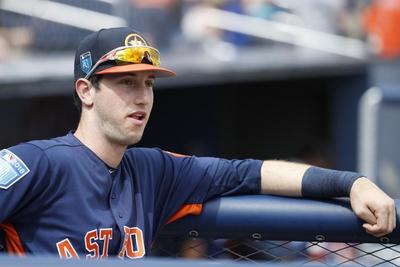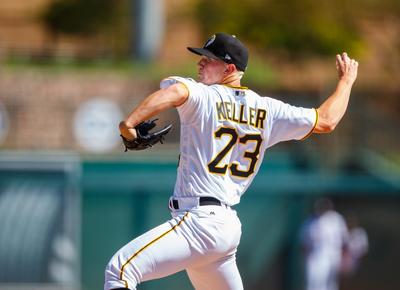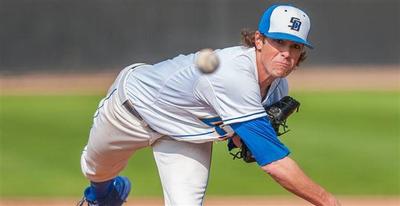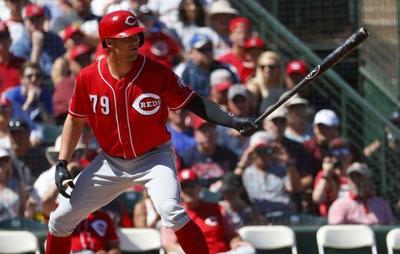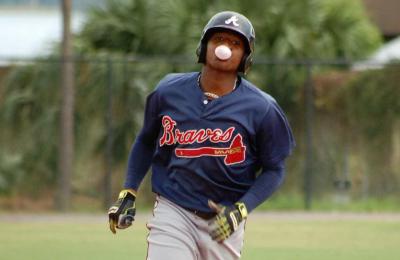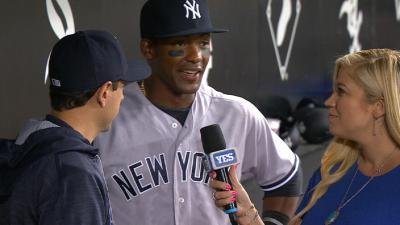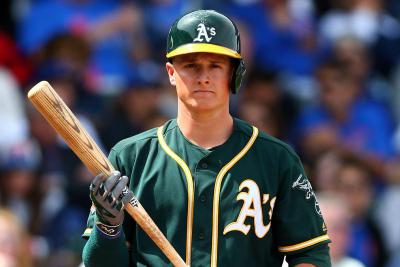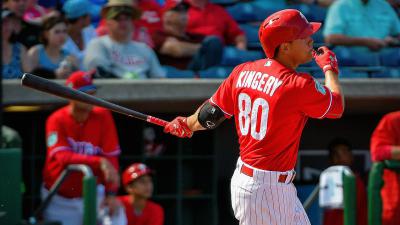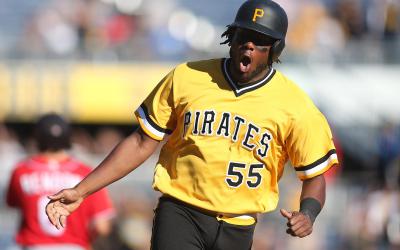Boston Red Sox
Will Middlebrooks- Cheap power at third or a dead spot in your fantasy lineup?
Few players were more Jekyll and Hyde in 2013 than Red Sox Third Baseman, Will Middlebrooks. The first half of the season in 2013 was a nightmare for Middlebrooks and his fantasy owners as he slashed his way to .192/.228/.389. Then, after spending some time in the minors working on his swing, Middelbrooks returned to the majors and put up a far more respectable .276/.329/.476 as he matched his early season power numbers, cut down on his strikeouts and even stole 3 bags. As Middlebrooks enters his power prime at age 25, the question remains: can we trust him to be a consistent source of reasonable fantasy production at third base? I believe the answer is yes, but with a bit of caveat emptor mixed in. Middlebrooks plate discipline statistics paints a very clear picture of a player who is not afraid to swing and miss. His 11.5% swinging strike rate and his 75% contact rate from 2013 seem like very real and accurate depictions of Middlebrooks' abilities at the plate. His 26.2% strike out rate is in line with a career that has seen him strike out in the high-teens to mid-twenties percentage wise throughout his career at all levels. These kind of swing and miss tendencies combined with a .335 BABIP in 2012 tends to support the idea that his .288 batting average that year was more mirage than anything. With all that being said, Middlebrooks power seems very, very real. His 39.1 % Flyball rate and 20.2% Line drive rates are solid, but the statistic that truly makes Middlebrooks valuable is his 17.2% HR/FB rate. This statistic can vary from year to year depending on different issues, but I would expect it to hold steady or tick back up towards the 2012 number of 21.4% considering the player's age and home ballpark. As long as you temper your expectations for his batting average and can stand to deal with a streaky hitter, I think Middlebrooks could be a draft day steal at his current ADP.
Jon Lester- Will the real Jon Lester please stand up?
I think it's fair to make two statements regarding Jon Lester at this point of his career. The first would be that 2012 Lester will probably end up being the outlier of his career as a ridiculously high HR/FB rate of 13.9% lead to a disastrous 4.82 ERA. The second statement is that Lester's days as a fantasy ace are almost assuredly behind him. In 2009-2011, Lester combined elite strike out numbers (26.7%, 26.1% and 22.8%) and elite Ground Ball rates (47.7%, 53.6% and 50.5%) to become one of the better pitching assets in the game. In his two most recent campaigns, Lester's strike out rates have dipped to 19.0% and 19.6%, which while nothing to sneeze at is not the elite level of his younger days. Meanwhile, his ground ball rate is in a four year decline from 2010, and it bottomed out last year at 45%, which is the lowest it has been since he become a regular member of the BoSox rotation. While all this may seem like very negative stuff, it is more just a testament to who Jon Lester is right now. He is a solid second or third member of a fantasy staff. As a consistent option that has thrown for over 190 innings in 6 straight seasons, Lester may not be the ace of your staff, but as long as he maintains a 18-20% K rate and a 6-8% BB rate, he definitely has a place. I'd look for a value similar to 2013 and ignore 2012 on draft day.
New York Mets
Curtis Granderson- Can the Grandy Man? Really? Can he?
The Mets made their first big free agent splash in a couple of years by signing Curtis Granderson away from their cross-town rivals the Yankees. Granderson flourished during his healthy seasons in the Bronx as an elite power source for fantasy owners smashing 40+ home runs in 2011 and 2012. After an injury riddled 2013, the move to Queens may leave fantasy owners with less than what they have come to expect from a healthy Granderson. First, we must note that if you are drafting Curtis, you should probably prepare to find some average help elsewhere in the lineup. There is no reason to believe his 28% strikeout rate is anything but real, and his Swinging Strike rate has increased each of the last three years topping out at an atrocious 13.6% during his limited plate appearances in 2013. The second thing that is worth noting is that the change in ballpark (Citi won't play as well for Granderson as Yankee Stadium, but won't be as negative as some might think) and age of the player will almost invariably sap some of the power that made him a fantasy star. Even had he stayed in Yankee Stadium, it would have been difficult to replicate his 20+% HR/FB ratios during his age 33 season. While he could still go for 20 home runs/10 steals, his terrible batting average puts him on the lower end of similar players. As with most assets, as long as you manage expectations and don't reach, Granderson still has value. It just isn't what it used to be.
Zack Wheeler- Where should expectations be?
After several years of hype as a top prospect, Zack Wheeler made his major league debut in 2013 to mixed results. Wheeler was able to keep his strikeout numbers respectable at a 19.5% K rate, but his 10.7% BB rate is more than just concerning because, frankly, it is a trend. Wheeler has sat around 10% on his walk rates since his days in the low minors. For years, we have written off his control issues as something that would stabilize as he ages. We now have almost 500 innings of professional data that suggest that this is just who Zack Wheeler is. His value in fantasy will be tied directly to his ability to begin to strike major league batters out at the rate he did in the minors. In leagues that count K/BB or WHIP, Wheeler will take a hit on his value due to his control issues. Could this improve as he ages? Certainly. Perhaps, he will repeat his delivery better or become more comfortable with challenging hitters in the zone. If you want to gamble on his talent, go for it. Just don't reach for him, because he hasn't figured out how to get the hitters to reach outside the zone just yet.
Tampa Bay Rays-
Wil Myers- Future Superstar takes center stage
Sometimes you have to preach cautious optimism to even the most zealous of believers. When it comes to Wil Myers, I am amongst those believers. I invested heavily in the American League rookie of the year in keeper formats, and I expect him to be a solid base for long term growth in those leagues. With that being said, we have to take a step back and realize he may not repeat a lot of his rookie year success. Primarily, his .293 batting average will almost assuredly regress in 2014. Myers sat at a .362 BABIP while striking out 24.4% of the time. This high singles rate helped inflate his batting average and made up for his high K rate. I expect this to regress. His power should remain stable, but there isn't a reason to expect a huge power surge from Myers yet. His Flyball and Line Drive rates are in line with the perceived league averages, and there isn't much there to predict a large increase for any reason outside of playing a full season in the big leagues. In keeper leagues, nothing about his statistics should be off-putting to have him as an early round pick, but I expect owner's to reach for him in re-draft leagues on the promise of potential. Its fine to dream on Myers, but be realistic for this year and realize that the long term value is really where he makes his owner's money.
Matt Moore- Will he ever be an ace or not?
Sadly, through the first two years of Matt Moore's career, the answer to the ace or not question is a pretty clear not. Moore has one very elite skill. He can strike out just about anyone on the planet when he is on his game. He has strike out rates of 23.1% and 22.3% in each of his last two seasons, and with those rates, he provides his owners with a strong chance to compete for that statistical category. The problem is he is probably losing his owners WHIP or K/BB at the same time. Moore has managed to exceed 10+% BB rates in both of those seasons as well. On top of his walk issues, Moore has also been prone towards the fly ball as he has averaged over 40% fly ball rates in each of the last two seasons. His ability to keep those balls inside the ballpark and strikeout opposing batters has minimized the damage of those fly balls, but there are few worse combinations than a guy who walks a lot of batters and gives up a lot of fly balls. Eventually, this combination leads to the dreaded multi-run home run. To add to the issues, Moore is generating less swinging strikes as hitters are not willing to chase his stuff outside of the zone. His swinging strike rate of 8.5% isn't really very impressive and feels strange given his advanced strikeout numbers. When you realize that Moore lost a TON of velocity on his fastball (down from 94.4 to 92.4), it makes more sense, but it doesn't really give you any more of a warm and fuzzy feeling about him coming into the 2014 season. Moore's age and K-rate make him a hard pitcher to sell on, especially if you have him for reasonable value in keeper leagues, but there are red flags a plenty for a pitcher who was once thought to be the next Tampa Bay ace.
Miami Marlins
Marcell Ozuna- Anything to see here?
Part of the story of the 2013 Marlins was their need to rush players to the big leagues in order to make up for an otherwise lackluster roster. In one case, that of Jose Fernandez, the rush proved to be the best call they could have made. In others, we were left wondering if perhaps the team made an error. This will be the question with Marcell Ozuna. Ozuna hit the ground running in May slashing .330/.372/.462. He never sniffed anything close to those numbers again. Penciled in as the Marlins starting 2014 centerfielder, Ozuna walked a paltry 4.5% of the time in 2014 while striking out 19.6% of the time. His .124 ISO was equally unimpressive. Generally, Ozuna hit for a middling average, with little to no power while not taking walks and striking out a lot. It is hard to expect much from a 23 year old who has had exactly 47 plate appearances above Class A ball before heading to the majors. I could go into an above average swinging strike rate, a below average contact rate and a tendency to swing at balls outside of the zone, but I think you get it. No, there is nothing to see here. Move along.
Nathan Eovaldi- Should I pay attention to a Marlins starter not named Fernandez?
As we move through the pre-season, I will be covering the Marlins and asking the same question: who, if anyone, from this rotation should fantasy owners pay attention to not named Jose Fernandez? We will start this investigation with Nathan Eovaldi. The right hander provided fantasy owners with reasonable spot start quality in 2013. With a FIP of 3.59 and a xFIP of 4.15, it is fair to say that Eovaldi had a bit of luck in getting to his 3.39 ERA on 2013, which is not all that encouraging for fantasy owners. His inability to consistently strike out batters (17.3%- a three year HIGH) while walking batters at a fairly high rate (8.9% for the second consecutive year) lead us towards the conclusion that Eovaldi is far from fantasy gold. He also tends to give up a fair amount of line drives (25.5%, 23.2% and 22.0% over three years). All of this is bad. The best thing I can say about Eovaldi is he manages to keep the ball in the yard as he has held batters to about a 6% or so HR/FB ratio. You have heard of the no doubles defense? Eovaldi might be the all doubles defense. Generally, even NL only owners can probably find more appealing options than Eovaldi, but certainly, that should be the only format where he is being carried for any reason whatsoever unless he flies in the face of all statistical trends. So in the first part of our four part expose on the Fish's rotation, we can say, almost unequivocally, no you should not pay attention to Nathan Eovaldi.
Around the league
Javier Baez (SS- CHC)- The Cubs today announced that they will trying top prospect Javier Baez at both second base and third base during spring training. Baez spent the better part of 240 plate appearances at Double-A in 2013 beating the living hell out of baseballs. His 17 home runs and .261 ISO at Single-A in 337 plate appearances would seem fantastic if he hadn't hit 20 home runs and a .344 ISO in Double-A in 97 less plate appearances. While Baez has his warts (28.8 K rate at Double-A which is only slightly higher than his career averages), he does not have that much more left to prove on the farm. There is a chance he breaks camp with the Cubs depending on his spring, but he will almost assuredly end up on the big league roster by June barring an absolute disaster. This is why the news of the Cubs trying to fit the young shortstop into other positions becomes even more intriguing. He already has shortstop eligibility in the Yahoo fantasy game, and he could see enough time at either (or both) second or third at some point this season to make him incredibly valuable. Keep an eye on this situation as Baez's stock is on the rise, and he may end up being a versatile asset in the coming season.
Jose Lobaton (C-WAS) - On Thursday, Jose Lobaton was traded from Tampa Bay to Washington. Fantasy owners can safely file this under "meh" for the time being. This only really becomes relevant for NL-only owners if Wilson Ramos goes down with an injury, which isn't so farfetched considering Ramos has only eclipsed 400 plate appearances once in his young career. Lobaton isn't a spectacular player by any stretch, but his decent walk rates (12.2% in 2012, 9.6% in 2013) and some decent pop (.144 ISO in 2013) means that NL-only owners should at the very least know his name now that he has switched leagues. He won't win you your league if Ramos gets hurt, but he probably won't embarrass himself either.
Fernando Rodney (RP- SEA) - The Mariners finalized their agreement with their newest closer, Fernando Rodney on Wednesday afternoon. This really does not affect Rodney's value for the coming season much at all. Rodney should still present owners with the opportunity to rack up between 30-40 saves. Many have said that pitching in Seattle will help Rodney, but I don't really think it will matter very much. Rodney survives on elite ground ball rates (5 years of above 50%) and low fly ball rates (22.5%, 24.6% and 24.7% the last three years) so the cavernous ballpark in Seattle really won't change all that much. Rodney's weakness, with the exception of 2012, has been and always will be his command. A 12.4% walk rate, which sadly is in line with most of his career averages, is really what could be Rodney's undoing, and that issue exists no matter what stadium he pitches in. For now, take him off the board with confidence the same way you would have if he was still in Tampa.
Stephen Drew (SS- FA) - Who wants a shortstop? C'mon somebody has got to want a shortstop, right? Right? I'll save the chilling effect of draft pick compensation for a non-fantasy related column (check those at MLBReports.com- cheap plug, sorry, I know). Fantasy owners should really pay attention to where Stephen Drew lands because while he isn't an elite fantasy option at shortstop, he is certainly better than a lot of folks at the position. Drew strikes out a ton (23.2% in 2012, 24.8% in 2013) and will probably not due your average any favors as his .253 average in 2013 was probably at least somewhat BABIP driven. With that being said, his .190 ISO was good for third at the position in 2013 behind Hanley and Tulo. Drew provides a decent bit of pop for a shortstop, which has value at that position. Hopefully, he will sign soon so we can properly project his 2014 season.
Taijuan Walker- (SP- SEA) - Word out of Seattle was that wonder kid Taijuan Walker is dealing with shoulder issues this offseason. This is obviously another negative for the Mariners, who recently learned that Hisashi Iwakuma suffered a hand injury that would cost him the beginning of the season. Walker had a cup of coffee with the Mariners during September of 2013. He did not flash his big strike out potential (28.3% at Double-A and 26% at Triple-A in 2013), but he held his own at 20% while limiting his walks to just 6.7%. Few prospects come with more hype than Walker, who was reportedly demanded in exchange for Tampa ace David Price during trade negotiations. Walker's question will be whether his strikeout stuff translates and if he can continue to limit his walks, something he had issues with at the minor league level as he walked between 8.9% and 11.1% of batters throughout his minor league career. Shoulder injuries are always scary for pitchers so let's hope that this is a bump in the road for a pitcher with a seemingly bright future. Obviously, keep your eye on his condition heading into draft season. It isn't time to bump him down draft boards yet, but that could come quickly if this turns out to be more serious.
Dylan Bundy- (SP- BAL)- Good news from Baltimore as it seems Dylan Bundy has resumed throwing from 120 feet in his recovery from Tommy John surgery. The O's will be increasingly careful with Bundy's recovery after the star prospect missed the entire 2013 season. His numbers at A-ball were amazing in 2012 as he was a strike out machine, but they began to tail-off as he was aggressively promoted through the Baltimore system. All expectations should be for Bundy to begin the season at Double-A and work his way back into shape. He can be ignored in all re-draft leagues, but should be a solid target for keeper leagues.
Albert Pujols- Perhaps the greatest right handed power hitter of our generation finally seemed to hit a wall in 2013 when a combination of injury and ineffectiveness reduced him to a mere mortal. If that wasn't flowery enough of an introduction to my Pujols report, I don't know what the hell will be. Albert told the media today that he has lost some weight and his knee and foot are both 100% going into 2014. Pujols will probably never again be the de facto number one fantasy pick he was in the mid-2000's, but his numbers suggest a bounce back is very possible. Albert still walks at a fair rate (9.0% in 2013) and does not strike out all that often (12.4%). His average seems like it is due to regress as his BABIP was 40 to 50 points off league average and at least 20 points off his three previous seasons. His ISO was down considerably in 2013, and the question will be was this an bat slowing down due to age or due to injuries in his legs. He is still an aggressive fly ball hitter (42%), but his HR/FB is in a three year decline (18.3%, 14.0% and 11.8%). My best guess is it is probably a little from column a and a little from column b. Owners should expect more than his 17 home runs in 2013, but the 30 home runs from 2012 would probably be his best case scenario. In either case, he should provide a valuable fantasy asset. Just not the Pujols of old.
Jason Hammel (SP- CHC) - Jason Hammel completed his one year deal with the Chicago Cubs on Thursday. Hammel regressed to his career means in 2013 after pitching like a borderline ace in 2012 for Baltimore. Hammel struck out 22.9% of batters in 2012 while inducing a career best 53.2% ground balls (he had never topped 46% in a 7 year major league career prior to 2012). To say that 2012 was the outlier is to put it mildly. Hammel seemed to throw his entire stable of pitches harder in 2012 than ever before as his velocity ranged increased at least a mile per hour on his fastball and slider while it increased almost 3 miles per hour on his change. I don't mean to be negative on Hammel, but nothing in his statistical history supports 2012 as anything more than an outlier. His FIP in 2013 was 4.93, his ERA was 4.97. Frankly, I just think that is who Jason Hammel is, and but for one year, has always been.

